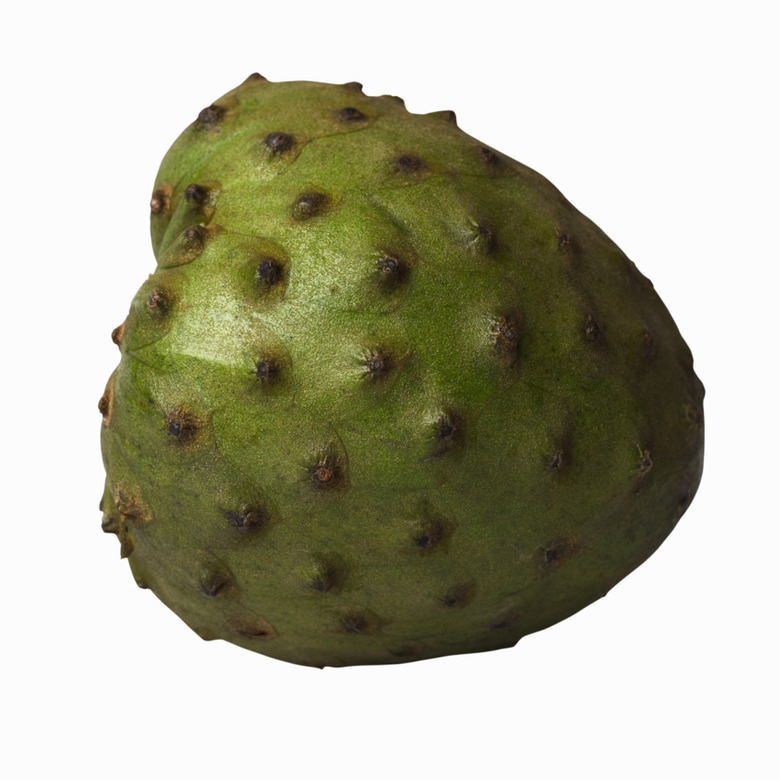Cherimoya & Soursop
Described by Mark Twain as "deliciousness itself," the cherimoya (Annona chermola) joins its cousin, the soursop (Annona muricata) among the unusual-looking fruits with surprisingly delicious insides. Growing and eating them brings a bit of Central and South America to your garden and your table.
Cherimoya Description
Step 1
Native to Andean valleys in Bolivia, Ecuador and Colombia, cherimoyas have a flavor described as a blend of bananas, pineapples, pears, lemons and other tropical fruits. The trees grow as tall as 30 feet, with low, spreading branches. Cherimoya trees produce a 4- to 8-inch heart-shaped fruit that opens easily to reveal a white, sweet pulp and 1/2- to 3/4-inch hard black seeds. You can scoop the flavorful pulp out like pudding, but the skin and seeds are inedible. In fact, the seeds are toxic if ingested, producing symptoms similar to atropine poisoning, including extreme light sensitivity, dilated pupils and nausea and vomiting.
- Described by Mark Twain as "deliciousness itself," the cherimoya (Annona chermola) joins its cousin, the soursop (Annona muricata) among the unusual-looking fruits with surprisingly delicious insides.
- In fact, the seeds are toxic if ingested, producing symptoms similar to atropine poisoning, including extreme light sensitivity, dilated pupils and nausea and vomiting.
Growing Cherimoya
Step 1
Cherimoyas thrive in the Mediterranean climes of U.S. Department of Agriculture plant hardiness zones 9 and 10. They prefer medium-weight soils and a pH level of 6.5 to 7.6. Although they will not tolerate extended exposure to high levels of humidity, cherimoyas do need regular watering, so give your trees a deep drink once a week during the warmer seasons. Harvest your sweet fruit while it is still green and allow it to ripen at room temperature for five to seven days.
Soursop Description
Step 1
Also known as guanabana, prickly custard apple and graviola, soursop (Annona muricata) produces the largest fruit of the 60 species in the Annona genus. Reaching 25 feet to 30 feet in height, soursops grow low, bushy branches. They produce compound fruits 4 inches to 1 foot in length, which weigh in at 10 to 15 pounds. Their green inedible skin sports soft, bendable spines, while the pithy, juicy interior contains hard black seeds in the fertile sections. Toxic if ingested, the seeds can also cause serious eye inflammation.
- Cherimoyas thrive in the Mediterranean climes of U.S. Department of Agriculture plant hardiness zones 9 and 10.
- Although they will not tolerate extended exposure to high levels of humidity, cherimoyas do need regular watering, so give your trees a deep drink once a week during the warmer seasons.
Growing Soursop
Step 1
Hardy in USDA zones 10 and 11, soursop trees are vulnerable to cold, suffering severe damage from only light frosts. They prefer rich, well-drained loam with a pH level of 6.1 to 6.5. Your soursop will thrive in full sun to partial shade and will do best with a deep layer of mulch in hot seasons, since they have shallow roots. Water your soursop often enough to keep the soil moist and fertilize it quarterly. During the first year, feed the tree 1/2 pound of a general purpose, 10-10-10 fertilizer, following that with 1 pound the second year and 3 pounds in succeeding years.
References
- Mother Nature Network: 15 Fruits You've Probably Never Heard Of
- Purdue University: Cherimoya
- Melissa's: Cherimoya
- Underwood Family Farms: Cherimoya
- Purdue University Horticulture and Landscape Architecture: Soursop
- University of Oklahoma Department of Microbiology & Plant Biology: Annona Muricata — Soursop
- University of California Cooperative Extension: Cherimoya
- Flowerdale Nursery & Landscaping: Chermoyas
- Pepe's Plants: Soursop
